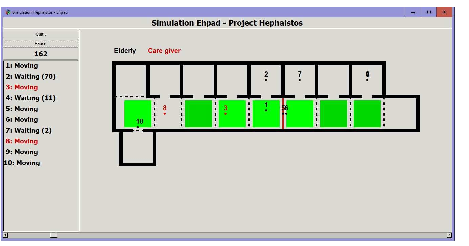Section: New Results
Smart Environment for Human Behaviour Recognition
Participants : Alain Coulbois, Aurélien Massein, Yves Papegay, Odile Pourtallier [correspondant] , Eric Wajnberg.
The general aim of this research activity focuses on long term indoor monitoring of frail persons. In particular we are interested in early detection of daily routine and activity modifications. These modifications may indicate health condition alteration of the person and may require further medical or family care. Note that our work does not aim at detecting brutal modifications such as faintness or fall.
In our research we envisage both individual and collective housing such as rehabilitation center or retirement home.
Our work relies on the following leading ideas :
-
We do not base our monitoring system on wearable devices since it appears that they may not be well accepted and worn regularly,
-
Privacy advocates adequacy between the monitoring level needed by a person and the detail level of the data collected. We therefore strive to design a system fitted to the need of monitoring of the person.
-
In addition to privacy concern, intrusive feature of video led us not to use it.
The main aspect that grounds this work is the ability to locate a person or a group in their indoor environment. We focus our attention to the case where several persons are present in the environment. As a matter of fact the single person case is less difficult.
This year we have focused our attention in several aspects : improvement of the hardware of the experimental monitoring system and tools for handling and analyzing the data gathered.
The PhD work about optimal location of sensors in a smart environments has been defended in november, defining new metrics on set of sensors and new methods (Design of Instrumented Environment for Human Monitoring, defended on 12/26/2018).
Hardware
Two monitoring systems have been installed. The first one in the first floor of EHPAD Valrose in Nice, and a second one in Institut Claude Pompidou in Nice. Both systems are composed of multi sensors barriers that provide raw data from which we deduce the time and direction of its crossing by a person.
For the second experimental system the analysis of the first data have shown that the system was not reliable enough while the data themselves were not satisfactory because of the specificity of the building (large corridors, large waiting room, picture windows and the number of sensors installed (77). We have worked on the hardware of the system (redundant power supply, better orientation of barriers, better communication system) to improve the gathered data.
Tools for handling data and data analysis
We have developed a simulation program, written in C and using the GTK library, that generates barrier-events (i.e. crossing time, direction of crossing, speed of crossing). This program is based on Monte Carlo procedures simulating the displacement of both elderly and caregivers in the EHPAD environment equipped with movement detectors. The code can simulate up to 20 persons and randomly draws room-to-room movements according to the walking speed of each individual (caregivers walk at a faster pace than elderly), and counts the locations and time coordinates of each movement event identified by the detectors. The figure 4 gives a view of the graphic interface. Such a simulation program, and the results produced, will provide basic training data to reconstruct patient movements from the information collected by the activity detectors.
Another scientific activities were based on the development of diagnostic tools (also written in C) to visualize (and thus to check and to interpret) events identified by each detector in such equipped environment. Finally, another activity – that is still under development – is to analyze statistically gait data obtained through the event detection. In this case, the goal is to build a series of relevant statistical descriptive parameters that will be used to describe, identify and compare gait features and pathology in medically assisted environments. This last part is developed used the R software.
In the two installed system data are collected continuously during the all day and a large number of barrier crossing is observed. We are currently comparing raw and simulated data before moving on with a statistical analysis.



